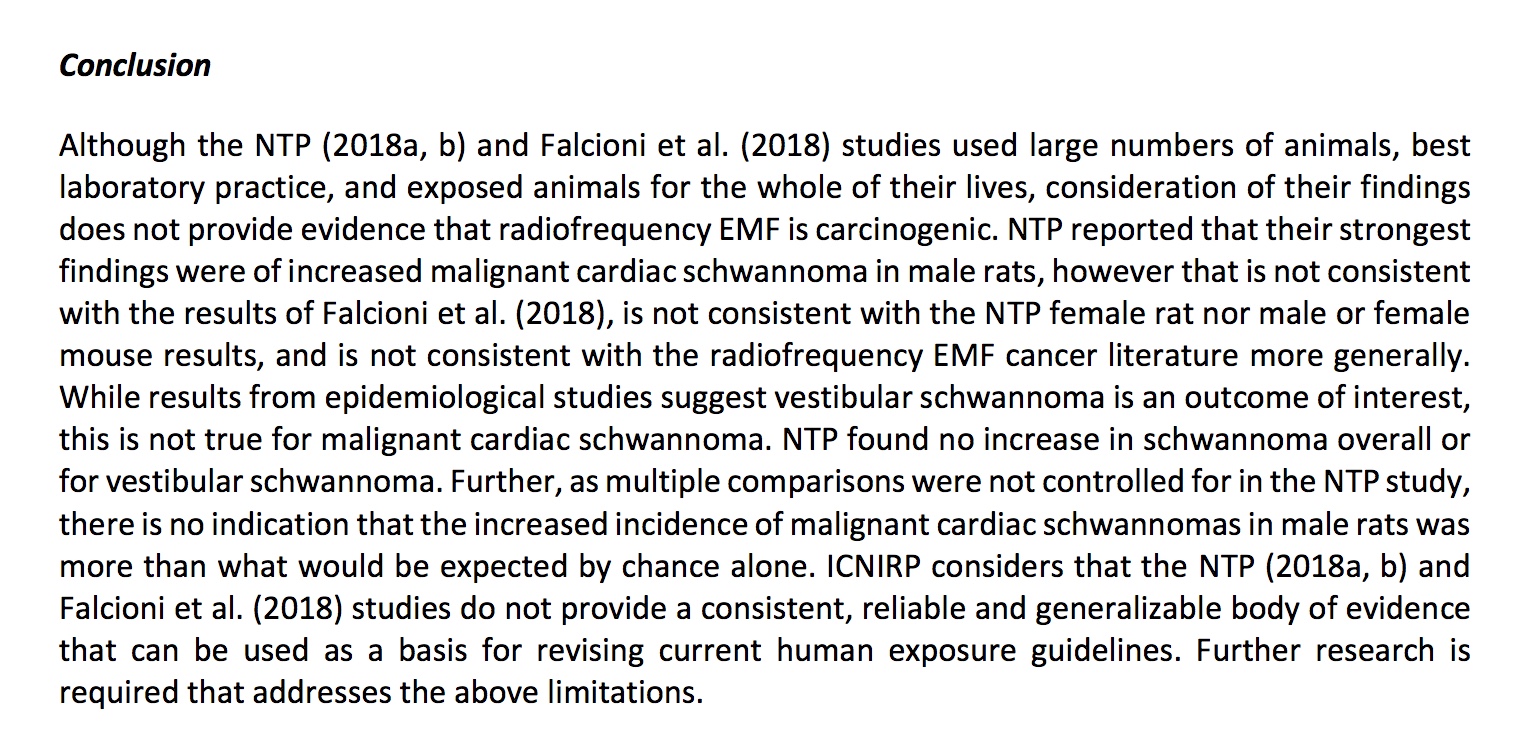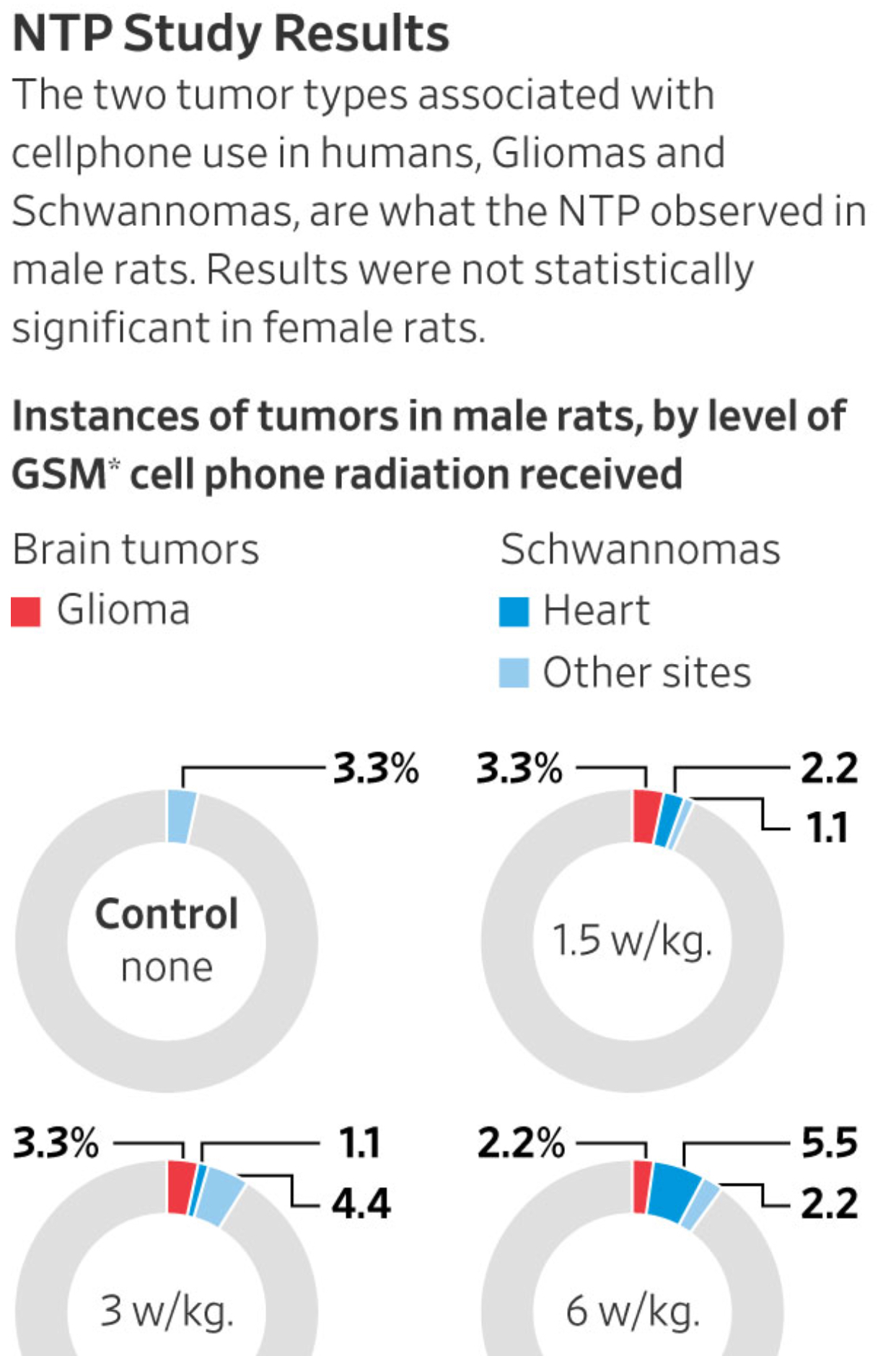2018 Short Takes
“Further Research Is Required”
The International Commission on Non-Ionizing Radiation Protection (ICNIRP) has determined that the two recent animal studies pointing to a cancer risk from cell phone radiation are not convincing and should not be used to revise current exposure standards.
In a “note” published today, the 12-member group states that the studies by the National Toxicology Program (NTP) and the Ramazzini Institute “do not provide a consistent, reliable and generalizable body of evidence.” “Both studies have inconsistencies and limitations that affect the usefulness of their results for setting exposure guidelines,” according to ICNIRP.
In contrast, a peer review panel of toxicologists and pathologists recently found that the NTP study showed “clear evidence” of RF carcinogenicity.
The current ICNIRP limits were set 20 years ago and are based only on acute effects. Two months ago, ICNIRP issued revised draft guidelines for public comment which are largely unchanged and also discount cancer risks.
Late last year, Maria Feychting, the vice chair of ICNIRP, was reported to be attempting to discredit the NTP study. See our “The Anatomy of a Rumor.”
On the other hand, Jim Lin, the editor-in-chief of Bioelectromagnetics and a 12-year former member of ICNIRP, recently wrote that, “Perhaps the time has come to judiciously reassess, revise and update [the ICNIRP] guidelines” so that they protect against long-term RF exposures.
Here are the conclusions of ICNIRP’s eight-page note, which was released today:

(L. Falcioni is the first author of the Ramazzini study.)
For more on the NTP study: go here.
And for more on the Ramazzini study, go here and here.
September 27, 2019
A somewhat different version of this Note has been published in Health Physics. It will appear in the March 2020 issue of the journal. A free download is available now from the ICNIRP website.
May 2, 2020
The Note has now been published. It appears in the May 2020 issue of Health Physics (open access).
Martin Blank died on June 13 at the age of 85.
A retired professor at Columbia University, Blank was a long-time EMF researcher, best known for his collaboration with Columbia’s Reba Goodman.
Writing in his 2014 book, Overpowered, Blank called himself an “unlikely activist” and urged people to practice precaution.
His obituary is posted on the Web site of the EMF Safety Alliance.
Notes from the NTP Press Conference
Here are four key takeaways from the NTP press conference held this afternoon, soon after the release of its two cell phone reports [these are no longer available]:
1. NTP’s bottom line on cell phone use: “This is not a high-risk situation.”
2. RF radiation has biological effects at levels previously believed to be innocuous —they may be good or bad.
3. NTP will continue to do RF health studies. A new exposure facility is being built on the NIEHS campus, which will be smaller and more flexible than the one used for the two-year exposures of the rats and mice in Chicago. It should be ready by late summer.
4. The finding that most impressed NTP was the increase of schwannoma of the heart in male rats. It was statistically significant. This was striking because of the similarity to acoustic neuroma, a tumor which has been reported in human studies. (For more on this, see our original story from May 2016.)
Of course, there is much else to delve into, notably the NTP analysis of DNA breaks, the incidence of brain tumors (glioma) among the male rats and the fact that they lived longer than the controls. The NTP attributes the significantly longer lifespan of the male rats to a lower incidence of chronic kidney disease (nephropathy). At the press conference, Dr. John Bucher, who led the project, suggested that the radiation might lessen inflamation which benefited the kidneys. (See also our previous coverage of DNA breaks in the NTP study.)
The NTP press release, “High Exposure to Radiofrequency Radiation Linked to Tumor Activity in Male Rats,” is here.
Even before the NTP released the two reports this afternoon, it posted an updated version of the “partial” report it issued on the rats in May 2016. The new report features a few tweaks and the addition of a new Appendix (B2), which responds to the criticism of NIH's Michael Lauer that have been frequently cited to counter concerns of a cell phone cancer risk.
After the release, Jeffrey Shuren, the director of the FDA’s Center for Devices and Radiological Health called the NTP evidence of a cancer risk “mostly equivocal or ambiguous.” The bottom line, he said, is that, “We believe the current safety limits for cell phones are acceptable for protecting the public health.” The FDA requested the NTP study back in 1999.
The NTP draft rat cell phone report runs 381 pages and the draft mouse report is 270 pages. They can both be downloaded here, where other related papers and data are also available. The NTP will hold a public peer review of the reports on March 26-28 in Research Triangle Park, NC.
An audio file of the press conference together with a transcript will be posted on the NTP Web site early next week, according to the NTP press office.
[February 6: The transcript and audio file are now available here.]
February 3
The headline in this morning’s New York Times story is “Rodent Studies Suggest Cellphones’ Risk to Humans in Minimal.” The title of the online version is “Cellphones Are Still Safe for Humans, Researchers Say.”
The Wall Street Journal took a different tack with “Why the Largest Study Ever on Cellphones and Cancer Won’t Settle the Debate.” The story included this useful graphic:

The Washington Post picked up the AP feed under “Cancer from Cellphones? New Studies Say No Need to Hang Up.” (Later in the day, it was changed to: “Studies Offer No Clear Answers on Safety of Cellphone Use.”) Meanwhile, the print editon ran a story by one of the paper’s staff reporters with the headline, “Human Health Conclusions Elusive After Cellphone Radiation Studies on Rodents.”
And Bloomberg ran with “Cell Phone Radiation Tied to Rare Tumor in Rats, Study Says.”
For more of Microwave News’ coverage of the NTP RF project, go here.
Peer Review Meeting March 26-28
The NTP has released two reports on the cancer risks from cell phone radiation (GSM and CDMA) on rats and mice. They are available here.
The NTP press release, “High Exposure to RF Radiation Linked to Tumor Activity in Male Rats” is here.
January 29, 12018
The National Toxicology Program (NTP) has announced that the draft reports on its $25 million animal study on the cancer risks associated with cell phone radiation will be released on February 2.
A peer review meeting is scheduled for March 26-28 in Research Triangle Park, NC.
Further details are available here. The Federal Register notice is here.
Preliminary results pointing to a cancer risk were published close to two years ago. See the Microwave News story that prompted the release here. For more of our detailed coverage, check out these links.
